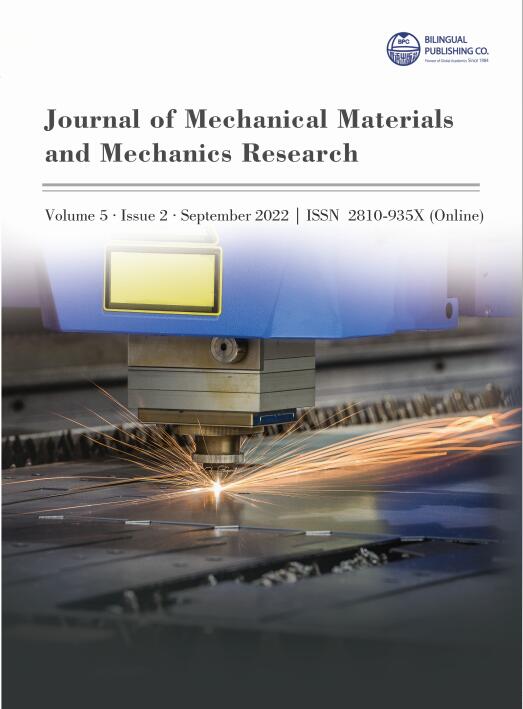-
219
-
126
-
82
-
79
-
72
Thermomechanical and Flow Analysis of a Typical Truck Radiator Using PTC-Creo
DOI:
https://doi.org/10.30564/jmmmr.v5i2.4601Abstract
In automobile engines, it is commonly known that the proper removal of the excess heat, resulted from internal combustion, is of high significance in the prevention of numerous negative consequences. In this regard, the radiator has a pivotal role as the main component of the engine’s cooling system. Hence, its design and analysis are highly important, requiring more comprehensive failure and flow investigations. In this work, a Scania radiator is examined under the thermal and mechanical loads, followed by its analysis under the combined thermomechanical loading. Then, the flow characteristics, including the velocity, pressure, and enthalpy, are studied. In this regard, PTC-Creo software is utilized. The results demonstrate that the thermal stress causes seven times more displacement than the mechanical one. When they are combined, this value reaches 1.5 mm. Also, the maximum failure index value of the Tresca theory is around 4.58, observed at the inlet side of the radiator. Besides, this paper indicates that the PTC-Creo can be considered as a reliable and economical tool for simulation of industrial applications, such as the considered radiator of a heavy-duty cooling system.
Keywords:
Radiator; Thermo-mechanical Analysis; Flow Analysis; PTC-Creo; ScaniaReferences
[1] Kasu, P.R., Ganesh, N.B., Kumar, K.S., et al., 2017. Analysis of heat dissipation in radiator of SI engine. International Research Journal of Engineering and Technology. 4, 160-166.
[2] Rahmati, A.R., Gheibi, A., 2020. Experimental and numerical analysis of a modified hot water radiator with improved performance. International Journal of Thermal Sciences. 149, 106-175.
[3] Amrutkar, P.S., Patil, S.R., 2013. Automotive radiator performance-Review. International Journal of Engineering and Advanced Technology. 2(3), 563-565.
[4] Eitel, J., Woerner, G.T., Horoho, S., et al., 1999. The aluminum radiator for heavy duty trucks. SAE Technical Paper. 1, 3727. DOI: https://doi.org/10.4271/1999-01-3721
[5] Aravindkumar, N., Vignesh, S., Kumaran, P., et al., 2020. Computational and numerical analysis of radiator with different tube structures and nano fluid as coolant. Materials Today: Proceedings. 45(Special Issue). DOI:https://doi.org/10.1016/j.matpr.2020.07.605
[6] Sheikhzadeh, G., Hajilou, M., Jafarian, H., 2014. Analysis of thermal performance of a car radiator employing nanofluid. International Journal of Mechanical Engineering and Applications. 2(4), 47-51.
[7] Molana, M., 2017. On the nanofluids application in the automotive radiator to reach the enhanced thermal performance: a review. Journal of Heat and Mass Transfer. 4(4), 168-187.
[8] Abbas, F., Ali, H.M., Shah, T.R., et al., 2019. Nanofluid: Potential evaluation in automotive radiator. Journal of Molecular Liquids. 297, 112014.
[9] Sathyan, R., 2016. Analysis of automobile radiator using computational fluid dynamics. International Journal of Latest Technology in Engineering, Management & Applied Science (IJLTEMAS). 5, 6.
[10] Chidley, A., Roger, F., Traidia, A., 2011. A Thermal-Shock Fatigue Design of Automotive Heat Exchangers. International Journal of Mechanical and Mechatronics Engineering. 5(1), 263-267.
[11] Roger, F., Chidley, A., 2013. Thermo-mechanical fatigue design of automotive heat exchangers. European Journal of Computational Mechanics. 22(2-4), 228-235.
[12] Gu, J., Yang, X.F., Ma, T., et al., 2013. The study of automotive aluminum alloy radiator tank’s leakage. Applied Mechanics and Materials. 364, 134-137.
[13] Baou, M., Afsharpanah, F., Delavar, M.A., 2020. Numerical study of enhancing vehicle radiator performance using different porous fin configurations and materials. Heat Transfer-Asian Research. 49(1), 502-518.
[14] Kim, T.K., Lee, S.M., Pae, S.M., 2017. Method of predicting radiator temperature distributions for thermal fatigue analysis. Journal of Mechanical Science and Technology. 31(10), 5059-5066.
[15] Amrutkar, P.S., Patil, S.R., Shilwant, S.C., 2013. Automotive radiator-design and experimental validation. Research and Development (IJAuERD). 3(4), 1-10.
[16] Shariff, K.B., Abdullahi, B., Abubakar, S.B., 2018. Modelling and simulation of car radiator: Effects of fins under the atmospheric condition of Kano, Nigeria. Journal of Advanced Research in Fluid Mechanics and Thermal Sciences. 48(1), 1-16.
[17] Mia, S., Hossen, S., 2019. Numerical observation of heat transfer and pressure behaviour in an automobile radiator. Journal of Mechanical Engineering. 49(2).
[18] Patel, H.V., Subhedar, D.G., Ramani, B., 2017. Numerical investigation of performance for car radiator oval tube. Materials Today: Proceedings. 4(9), 9384-9389.
[19] Kasu, P.R., Ganesh, N.B., Kumar, K.S., et al., 2017. Analysis of heat dissipation in radiator of SI engine. International Research Journal of Engineering and Technology. 4, 160-166.
[20] Bonato, M., 2020. From Manufacturing Process Control to In-Field Reliability: Case Study of Automotive Heat Exchangers [Internet]. 2020 Annual Reliability and Maintainability Symposium (RAMS) [Published 2020 January 27]. pp. 1-7. Available from: https://dl.acm.org/doi/10.1109/RAMS48030.2020.9153724
[21] Goyal, N., Kaushik, A., Ram, M., 2016. Automotive water cooling system analysis subject to time dependence and failure issues. International Journal of Manufacturing, Materials, and Mechanical Engineering (IJMMME). 6(2), 1-22.
[22] Henrik, A., 2006. Energiteknik Edition. pp. 360-370. ISBN: 9789144045092.
[23] Tenkel, F.G., 1974. Computer Simulation of Automotive Cooling Systems. SAE Technical Paper. 2, 1. DOI: https://doi.org/10.4271/740087
[24] Global Auto Parts & Accessories Marketplace [Internet]. SCANIA Radiator 1365371. Available from: http://bonamotor.en.gasgoo.com/auto-products/1450301.html
[25] Aluminium Matter Organization UK. [Interner]. Available from: https://european-aluminium.eu/
[26] Ellis, D.E., 1960. Mechanical properties of aluminum alloys at various temperatures. Atomics International. Div. of North American Aviation, Inc., Canoga Park. United States: N. Available from: https://www.osti.gov/biblio/4097760
[27] Peyghambarzadeh, S.M., Hashemabadi, S.H., Naraki, M., et al., 2013. Experimental study of overall heat transfer coefficient in the application of dilute nano fluids in the car radiator. Applied Thermal Engineering. 52(1), 8-16.
Downloads
How to Cite
Issue
Article Type
License
Copyright © 2022 Jafar Mahmoudi

This is an open access article under the Creative Commons Attribution-NonCommercial 4.0 International (CC BY-NC 4.0) License.




 Jafar Mahmoudi
Jafar Mahmoudi





